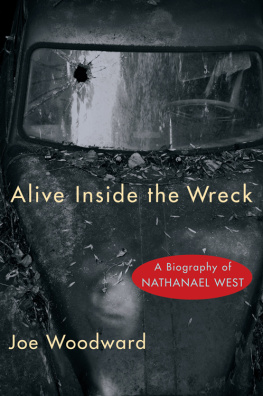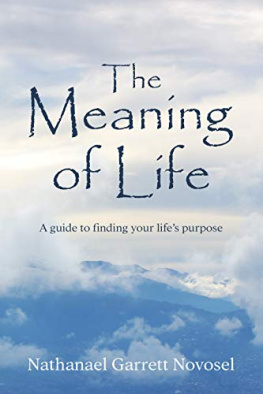
ALIVE INSIDE THE WRECK
A Biography of Nathanael West
ALIVE INSIDE THE WRECK
A Biography of Nathanael West
Joe Woodward

OR Books
New York London
2011 Joe Woodward
Visit our website at www.orbooks.com
First printing 2011
All rights reserved. No part of this book may be reproduced or transmitted in any form or by any means, electronic or mechanical, including photocopy, recording, or any information storage retrieval system, without permission in writing from the publisher, except brief passages for review purposes.
Library of Congress Cataloging in Publication Data: A catalog record for this book is available from the Library of Congress.
British Library Cataloging in Publication Data: A catalog record for this book is available from the British Library.
Typeset by Wordstop, Chennai, India.
Printed by BookMobile, USA, and CPI, UK.
The U.S. printed edition of this book comes on Forest Stewardship Council-certified, 30% recycled paper. The printer, BookMobile, is 100% wind-powered.
paperback ISBN: 978-1-935928-39-3
ebook ISBN: 978-1-935928-38-6
In America violence is idiomatic. Read our newspapers. To make the front page a murderer has to use his imagination, he also has to use a particularly hideous instrument. Take this mornings paper: FATHER CUTS SONS THROAT IN BASEBALL ARGUMENT. It appears on an inside page. To make the first page, he should have killed three sons and with a baseball bat instead of a knife. Only liberality and symmetry could have made the daily occurrence interesting.
Some Notes on Violence
Nathanael West
Contact, October 1932
Forget the epic, the master work. In America fortunes do not accumulate, the soil does not grow, families have no history. Leave slow growth to the book reviewers, you only have time to explode. Remember William Carlos Williams description of the pioneer women who shot their children against the wilderness like cannonballs. Do the same with your novels.
Some Notes on Miss L.
Nathanael West
Contempo, May 1933
PREFACE
Nathanael West worried over America: its landscape, its people, its future, its art. During the whole of the 1930s when West published his four short novels, The Dream Life of Balso Snell (1931), Miss Lonelyhearts (1933), A Cool Million (1934), and The Day of the Locust (1939), there was plenty to worry about. America had collapsed, caved in. Europe was in step. Yet what interested West most was how to fashion himself into a great American writer, in essence, how to write The Great American Novel. He settled, finally, on two ingredients: violence and brevity. You only have time to explode, he said. And he did.
THE ACCIDENT
The accident happened at five minutes to three, two days before Christmas: December 22, 1940. Rain puddles stood in the dips of the road from a morning storm. Broken thunderclouds lingered over the flat California desert. Nathanael West was on his way home.
The Woody station wagon held Wests new wife Eileen and their liver-colored pointer, Julie. As he crossed the intersection where Route 111 runs into U.S. Highway 80, West and Eileen collided with the Dowless familya husband and wife and two-year old daughter. West was traveling north out of Mexico after a weekend hunting trip. His car was full of dead quail and duck, the legal limit. Four shotguns rattled loose on the back seat.
West should have stopped at that intersection and turned left, but he didnt. A notoriously bad driver, West was easily distracted by conversation and daydream. After the accident, many of Wests friends recalled numerous near misses on the open road. One friend spoke about narrowly missing a group of school children crossing a street; another mentioned a wrong turn that ended with the car precariously dangling over the edge of a bridge.
The police report filed that afternoon recorded four feet of tire skids into the intersection, so West must have realized what was coming. The collision spun the Woody around, unlatching all four doors. Eileen flew out the passenger door and landed in the drainage ditch at the side of the road. West came to a rest across from her. The dog was injured, but fine. The paper reported: The dog was cut with glass in a number of places... and was running around attempting to get back into the station wagon.
The Dowless white Pontiac was more than forty feet east of the Wests, balancing on the edge of the road. Mrs. Dowless suffered a broken leg and a shattered pelvis. Mr. Dowless severed an artery in his left arm. The little girl, the Dowless daughter, was unharmed.
Its known from the police report and the single journalist at the scene that after the initial squeal and skirr of the crash both Nathanael and Eileen remained alive for a time. In the newspaper photo, steam rises up out of the torn engine, gasoline drips, oil and water pool on the road. There is a suggestion in the photograph of a hard afternoon wind pushing sand across the desert, small funnels of dust in the distance.
The first house east of the intersection phoned the accident into the county sheriffs office. It took over thirty minutes for a single patrol car to arrive from Calexico. It took another half-hour for an ambulance to come (without a doctor). The Imperial County Hospital was just three miles away from the scene of the accident, but in this case close proximity wasnt the same thing as good luck. No bystander acted, either.
Even after making it to Imperial County Hospital there was trouble. The hospital was hardly equipped to save lives. It was meant to bandage migrant field workers and get them back on the job.
With West, its always best to start with the wreckage and work your way back. Its best to move quickly through the early promise, the idyllic youth, and into the complications that followedhis stumbling walk through college into manhood, how and why he returned to Hollywood again and again to write for the movies, how the withdrawn Easterner became the artist, the novelist. Paris, too. The novels. The final masterpiece outlined, but never finished. The farm in Erwinna, Pennsylvania. The cheap apartments off Sunset Boulevard. The last house. The last weekend spent hunting across the border in Mexico. The Leon dOro, Mexicali. Alvarez, the man who owned the Leon dOro, who commanded West come to Mexico in December because the hunting was good. Alvarez was the man who told West the storm would pass. It would not.
THE STRANGE AMALGAM
A writer is what a writer does, not what he means to do: the novelist makes novels, and when the work is finished it stands alone. Art is not the dream, but the dream transcribed. As the writer moves from the unconscious to the concrete, the scaffolding of dreams falls away, leaving the made thing, the built thing. This is why writers are often such errant critics of their own workthey cannot see their cathedrals through the scaffolding of dreams.
Nathanael West was one of the great builders in American literature, a great novelist, but he did not know it. All his life his career existed as negative space. He founded no literary school, nor belonged to one. His reputation was fixed almost completely postmortem, and it grows today despite the size of his canon (barely four hundred published pages) and the scope of his influence on his contemporaries (practically nil). It is fair to say Nathanael Wests stature as a great American novelist rests solely on the force of his books.
His talent as a writer, like his reputation, developed slowly, the result of perfecting his craft. All his novels but one took four years to complete; all were drafted in his own hand, in large, looping, boyish writing with just four or five words per line. He moved from pencil to yellow pad through successive typescript drafts until he exhausted himself and the story. He developed an original scheme for each book and played them out in a spare prose. He let the specific stand for the universal. We know, for example, that The Day of the Locust is not merely about vacuous Hollywood; its about our universal love of glimmering facades and self-illusion. Its a book of warnings.
Next page











